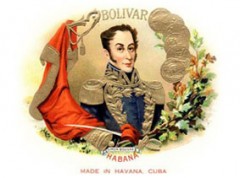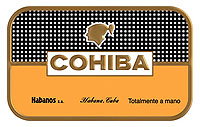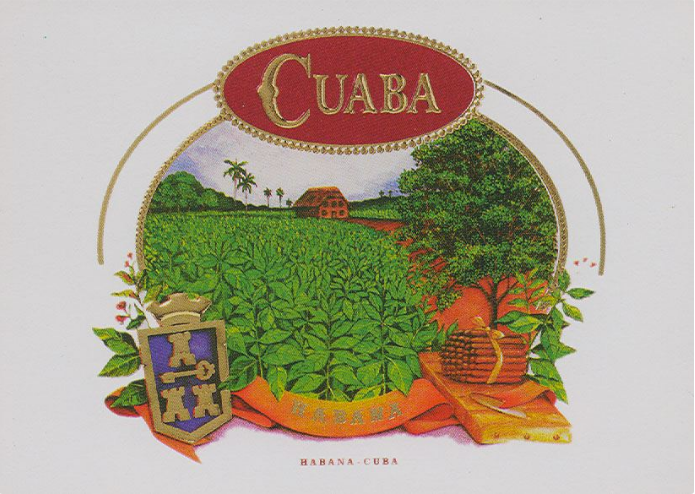- Products
 Simón Bolívar was one of the great historic figures of the 19th Century who liberated much of South America from Spanish rule. The Bolívar brand was created in 1902 and is based today at the Partagas factory in the heart of Havana. It is perhaps not surprising that a Habano named after such a powerful figure is blended to match his might. Bolívar is among the strongest, most full bodied of all Habanos. It boasts an unrivalled richness of flavour in its blend of Vuelta Abajo zone filler and binder tobaccos that makes it one of the most sought-after marques amongst experienced smokers.
Simón Bolívar was one of the great historic figures of the 19th Century who liberated much of South America from Spanish rule. The Bolívar brand was created in 1902 and is based today at the Partagas factory in the heart of Havana. It is perhaps not surprising that a Habano named after such a powerful figure is blended to match his might. Bolívar is among the strongest, most full bodied of all Habanos. It boasts an unrivalled richness of flavour in its blend of Vuelta Abajo zone filler and binder tobaccos that makes it one of the most sought-after marques amongst experienced smokers.
 Cohiba is the flagship brand of Habanos. It was created in 1966 for President Fidel Castro himself and was made at the then top secret, but now world famous, El Laguito factory. At first, it was only seen outside Cuba as gifts for heads of state and visiting diplomats. Since 1982 Cohiba has been available in limited quantities to the open market.
Cohiba is the flagship brand of Habanos. It was created in 1966 for President Fidel Castro himself and was made at the then top secret, but now world famous, El Laguito factory. At first, it was only seen outside Cuba as gifts for heads of state and visiting diplomats. Since 1982 Cohiba has been available in limited quantities to the open market.
 Every Cuaba is made in the distinctive shape known as double figurado, the style that at the end of the 19th Century was all the rage for Habanos. A century later, in 1996, this rich tradition was revived at the Romeo y Julieta factory. Double figurados are at the pinnacle of the cigar maker’s art and for this alone they merit a place in every cigar enthusiast’s collection.
Every Cuaba is made in the distinctive shape known as double figurado, the style that at the end of the 19th Century was all the rage for Habanos. A century later, in 1996, this rich tradition was revived at the Romeo y Julieta factory. Double figurados are at the pinnacle of the cigar maker’s art and for this alone they merit a place in every cigar enthusiast’s collection.
 Herman Upmann was a banker from Germany who so loved Cuban cigars that he moved to vista-hupmannHavana in 1844 and set up as both banker and cigar maker. His bank closed in the early 1920’s but his cigars live on as a fine example of an elegant, light to medium flavoured Habano. H. Upmann’s blend is composed exclusively of filler and binder tobaccos grown in the Vuelta Abajo zone.
Herman Upmann was a banker from Germany who so loved Cuban cigars that he moved to vista-hupmannHavana in 1844 and set up as both banker and cigar maker. His bank closed in the early 1920’s but his cigars live on as a fine example of an elegant, light to medium flavoured Habano. H. Upmann’s blend is composed exclusively of filler and binder tobaccos grown in the Vuelta Abajo zone.
 Hoyo de Monterrey owes its origin to the town of San Juan y Martinez , which lies at the heart of the Vuelta Abajo tobacco zone. Here the Hoyo de Monterrey plantation, one of the great Vegas de Primera, can be reached through a gate on the town’s main square inscribed ‘Hoyo de Monterrey. José Gener. 1860’. ‘Hoyo’ literally means a ‘hole’ and in this case describes the low-lying position of the plantation on the fertile banks of San Juan y Martinez river. José Gener, a Spaniard from Tarragona, first used the name of his vega on a brand of Habanos in 1865. The flavour of Hoyo de Monterrey’s blend makes it an attractive choice for those who seek a delicate yet aromatic Habano that is lighter to the taste but with great elegance and complexity.
Hoyo de Monterrey owes its origin to the town of San Juan y Martinez , which lies at the heart of the Vuelta Abajo tobacco zone. Here the Hoyo de Monterrey plantation, one of the great Vegas de Primera, can be reached through a gate on the town’s main square inscribed ‘Hoyo de Monterrey. José Gener. 1860’. ‘Hoyo’ literally means a ‘hole’ and in this case describes the low-lying position of the plantation on the fertile banks of San Juan y Martinez river. José Gener, a Spaniard from Tarragona, first used the name of his vega on a brand of Habanos in 1865. The flavour of Hoyo de Monterrey’s blend makes it an attractive choice for those who seek a delicate yet aromatic Habano that is lighter to the taste but with great elegance and complexity.
 La Gloria Cubana is a little known jewel amongst Habano brands. Nevertheless it enjoys a long history. Founded in 1885, its name alone clearly defines its origin. For over a century it has attracted a small but loyal following amongst the most knowledgeable smokers. The brand is characterized by its elegant presentation, especially in the Medaille d’Or Series.
La Gloria Cubana is a little known jewel amongst Habano brands. Nevertheless it enjoys a long history. Founded in 1885, its name alone clearly defines its origin. For over a century it has attracted a small but loyal following amongst the most knowledgeable smokers. The brand is characterized by its elegant presentation, especially in the Medaille d’Or Series.
 Montecristo is the best known and probably the most appreciated brand of Habanos throughout the world. It forms the benchmark for many Habanos smokers against which other brands are judged. The name comes from the hero of Alexandre Dumas’ famous novel ‘The Count of Montecristo’, which was a firm favourite when read by the Lector to the Torcedores (cigar makers) at the factory where it was founded in 1935.
Montecristo is the best known and probably the most appreciated brand of Habanos throughout the world. It forms the benchmark for many Habanos smokers against which other brands are judged. The name comes from the hero of Alexandre Dumas’ famous novel ‘The Count of Montecristo’, which was a firm favourite when read by the Lector to the Torcedores (cigar makers) at the factory where it was founded in 1935.
If there is one particularly famous cigar factory in Havana, it is Partagas. You can find it at No. 520 Industria Street, just behind the Capitol building, in the heart of the city. The factory was opened in 1845 by Don Jaime Partagas and it has been making the cigars that bear his name ever since. A Partagas is immediately recognisable by its deep, earthy flavour. The character of its blend springs from a selection of filler and binder tobaccos grown in the Vuelta Abajo zone and chosen for their unmistakable richness of flavour and aroma.
 Por Larrañaga is a brand with a long history. Founded in 1834 it enjoys a well-earned reputation for its consistency and good presentation. All the filler and binder tobaccos in Por Larrañaga come from the Vuelta Abajo zone. The range includes cigars made using both the Tripa Larga, Totalmente a Mano – long filler, totally handmade – technique, and the Tripa Corta, Totalmente a Mano – short filler, totally handmade – method. The short filler size also incorporates tobacco leaves from the Semi Vuelta zone.
Por Larrañaga is a brand with a long history. Founded in 1834 it enjoys a well-earned reputation for its consistency and good presentation. All the filler and binder tobaccos in Por Larrañaga come from the Vuelta Abajo zone. The range includes cigars made using both the Tripa Larga, Totalmente a Mano – long filler, totally handmade – technique, and the Tripa Corta, Totalmente a Mano – short filler, totally handmade – method. The short filler size also incorporates tobacco leaves from the Semi Vuelta zone.
 Punch is one of the very oldest Habano brands. Don Manuel López of Juan Valle & Co founded it in the mid 19th Century with an eye to the booming British market where a humorous magazine of the same name was much in vogue. A contented Mr Punch, the clown who personified the magazine, is still featured in every box, cigar in hand, and surrounded by 19th Century images of cigar making that remain virtually unchanged over a century and a half later. In 1931 the Punch became associated with Hoyo de Monterrey and the two brands have been made at the same factory ever since. Today the factory is La Corona.
Punch is one of the very oldest Habano brands. Don Manuel López of Juan Valle & Co founded it in the mid 19th Century with an eye to the booming British market where a humorous magazine of the same name was much in vogue. A contented Mr Punch, the clown who personified the magazine, is still featured in every box, cigar in hand, and surrounded by 19th Century images of cigar making that remain virtually unchanged over a century and a half later. In 1931 the Punch became associated with Hoyo de Monterrey and the two brands have been made at the same factory ever since. Today the factory is La Corona.
 Ramón Allones is one of the big names in the history of Habanos. Founded in 1837, it is also one of the oldest brands still in production. A Galician by birth Ramón Allones was the first cigar manufacturer to pack his Habanos in boxes decorated with labels and stamped with his brand’s emblem. He was the pioneer of the packaging tradition that we know today. All the sizes are filled with a blend of filler and binder tobaccos from the Vuelta Abajo zone, characterized by their intense and complex taste.
Ramón Allones is one of the big names in the history of Habanos. Founded in 1837, it is also one of the oldest brands still in production. A Galician by birth Ramón Allones was the first cigar manufacturer to pack his Habanos in boxes decorated with labels and stamped with his brand’s emblem. He was the pioneer of the packaging tradition that we know today. All the sizes are filled with a blend of filler and binder tobaccos from the Vuelta Abajo zone, characterized by their intense and complex taste.
 Named after William Shakespeare’s tragic lovers, the origins of Romeo y Julieta as a Habano date back to 1875. The brand rose to international fame during the early years of the 20th Century under the direction of Don ‘Pepin’ Rodríguez, a talented promoter, who was amongst the first to recognize the power of the cigar band. During his heyday, no less than 20,000 different bands were used in production. Winston Churchill became a devotee of the brand. Following his visit to Havana in 1946, his name has not only been commemorated on a band but it has also served to describe the marque’s most famous size – Romeo y Julieta Churchills.
Named after William Shakespeare’s tragic lovers, the origins of Romeo y Julieta as a Habano date back to 1875. The brand rose to international fame during the early years of the 20th Century under the direction of Don ‘Pepin’ Rodríguez, a talented promoter, who was amongst the first to recognize the power of the cigar band. During his heyday, no less than 20,000 different bands were used in production. Winston Churchill became a devotee of the brand. Following his visit to Havana in 1946, his name has not only been commemorated on a band but it has also served to describe the marque’s most famous size – Romeo y Julieta Churchills.
 Trinidad is named after the beautiful 16th Century city of La Santísima Trinidad (The Holy Trinity), listed by UNESCO as a World Heritage Site, which is situated on Cuba’s south coast. Trinidad, as a Habano brand, dates back to 1969 but for many years, like Cohiba, it was made only for gifts to foreign diplomats. Not until 1998 was it released for general sale and then only in small quantities.
Trinidad is named after the beautiful 16th Century city of La Santísima Trinidad (The Holy Trinity), listed by UNESCO as a World Heritage Site, which is situated on Cuba’s south coast. Trinidad, as a Habano brand, dates back to 1969 but for many years, like Cohiba, it was made only for gifts to foreign diplomats. Not until 1998 was it released for general sale and then only in small quantities.

